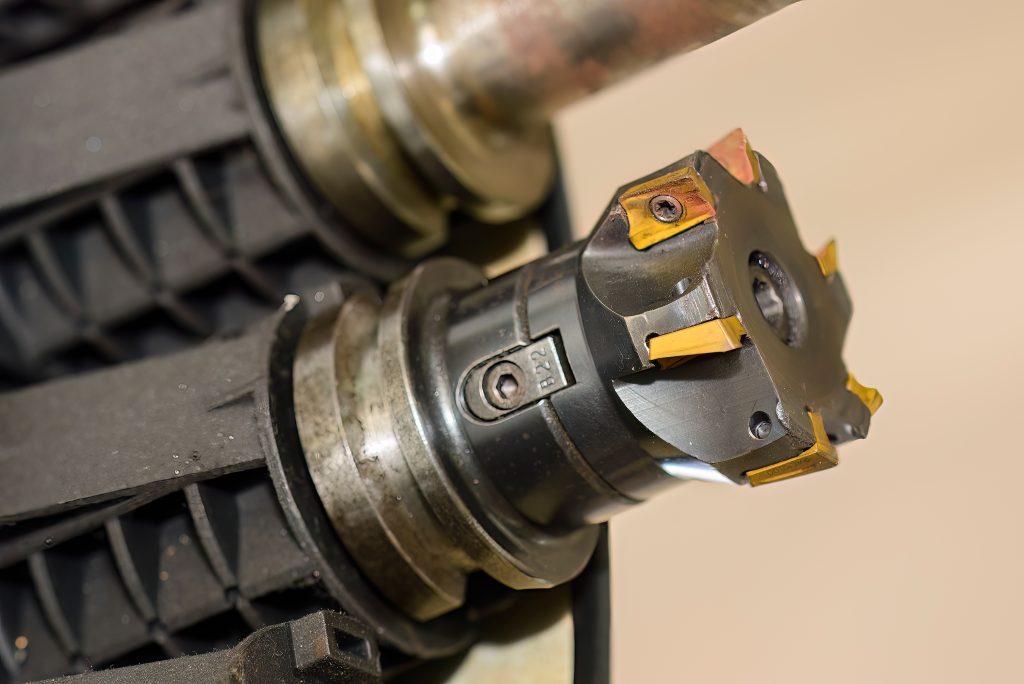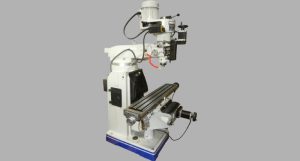Face milling is a machining process that uses a cutter with teeth on its surface and periphery to create a flat, smooth surface on a workpiece, with the cutter axis typically perpendicular to the milled surface.
What is Face Milling?
Face milling, an essential operation in the machining world, primarily serves to create a flat surface, or face, on a workpiece. It relies on a cutter with teeth on its surface and periphery to slash away material from the workpiece. Unlike other milling methods, the cutter axis is perpendicular to the surface being milled, resulting in a neat, smooth finish.
Let’s think of it like mowing a lawn. Imagine the grass as the workpiece, and the lawnmower as the face mill cutter – just as the lawnmower cuts across the entire width of the grass, bringing it to a uniform level, the face mill does the same to your material! Its efficiency, coupled with the precise flat surface it delivers, makes face milling an indispensable technique in industries like automotive, aerospace, and die manufacturing.
Face Milling Operations
Let’s explore various face milling operations geared toward specific machining needs:
General Face Milling:
This is the typical method used in face milling. It involves the cutter removing material across the entire ‘face’ of the workpiece. Its primary goal is to achieve a flat surface with excellent surface finish, and it’s used across a broad range of applications and materials.
Heavy-Duty Face Milling:
Heavy-duty face milling is employed when a significant amount of material needs to be removed, often from tougher workpiece such as those made from hard metals. This operation uses sturdy and resilient cutters that can withstand high levels of mechanical stress.
High-Feed Milling:
High-feed milling operates on the concept of faster feed rates and shallow depth of cuts. This method is used when speed is a priority over finish, often deployed in roughing operations where large volumes of material need to be quickly removed.
Finishing with Wiper Inserts:
After the primary face milling pass, wiper inserts offer a final ‘finishing’ stage to the workpiece. These specialized inserts enhance the surface finish, providing a smooth, polished end product without the need for additional polishing or grinding operations.
Face Milling vs. Other Milling
Face milling holds distinct differences when compared with other types of milling:
By design, face milling uses a cutter with teeth on the bottom and periphery that cut against the workpiece to remove material, all while creating a smooth, flat surface. Other forms of milling, such as slot or form milling, focus on cutting slots in the material or creating intricate forms and shapes, which is a marked contrast to the flat surface goal of face milling.
In a comparison against peripheral milling, face milling stands out as the cutter’s axis in face milling is perpendicular to the workpiece surface, whereas in peripheral milling, it is parallel. This difference in cutter orientation results in varied machining outputs.
Face milling also tends to excel in breadth. Unlike end milling, which primarily focuses on producing details with the tip of the cutter such as pockets and slots, face milling typically removes material across the entire ‘face’ of the workpiece.
Another valuable difference to note is between face milling and plunge milling. Plunge milling involves driving the cutter vertically into the workpiece and using only the tip of the cutter. Meanwhile, in face milling, the entire cutting edge of the cutter engages the workpiece, making it more suitable for large surface area machining.
Face Milling Cutters
Face milling tools are the pillars of the face milling operation. They come in different shapes and styles ideally suited to different tasks, much like the varying shapes and sizes found in a professional chef’s knife set.
Face milling cutters can be categorized based on several factors:
- Shape: The most common shape is the “shell” mill, where the cutter features a central hole to be mounted on an arbor. However, “end” mills, named for their ability to mill on the end or side, are utilized for their versatility.
- Material: High-Speed Steel (HSS) provides a versatile and cost-effective option for lower volume or less demanding applications. Meanwhile, carbide tools, with their increased hardness and heat resistance, are best suited for high-speed, high-volume machining.
- Number of Teeth: Also known as flutes or inserts, the number can vary. A larger number of teeth provides a smoother finish but requires slower feed rates. It’s a trade-off between speed and finish quality.
Choosing the right tool for your face milling operation is like selecting the right utensil for your cooking recipe. High-speed steel mills could be your everyday spatula, while carbide tools might be the carefully chosen chef’s knife for precision tasks.
To select the correct tool, one must consider several factors:
- Work Material: Hard materials require a harder, more wear-resistant material like carbide. Softer materials can often be worked with HSS cutters.
- Application Depth: Shallow surface work suits a cutter with many teeth for that smooth finish. Deeper applications might require cutters with larger flutes for effective chip evacuation.
- Production Volume and Speed: High-volume, high-speed production jobs benefit from carbide cutters. For lower volumes, a cost-effective HSS cutter might be more practical.

Steps in the Face Milling Process
The face milling process follows a sequential order, with each step meticulously planned and executed. Here are the necessary steps:
Identify Requirements:
Understand the milling needs, including the material, finish requirements, and tolerances. The project’s specifications will guide the subsequent steps.
Selection of Tools:
Based on the determined requirements, select the appropriate face milling cutter. Matching the tool to the task is crucial to ensure effective milling and quality outcomes.
Machining Parameters Definition:
Set the correct machining parameters, including the spindle speed (RPM), feed rate, depth of cut, and the coolant flow. This essential step optimizes machine performance and the quality of resulting workpieces.
Mount and Secure Workpiece:
Assign the workpiece a secure place on the machine table by clamping it firmly. This ensures its placement remains steady throughout the milling process, avoiding any deviations or inaccuracies.
Milling Operation:
Initiate the milling process along the planned toolpath, adhering strictly to predefined feeds and speeds.
Inspection and Finishing:
After milling, inspect the workpiece concerning desired dimensions and surface finish. If the result doesn’t meet the set parameters, adjustments are required, and the process may be repeated.
Cleanup:
Post milling and inspection, execute proper cleanup of the workspace and tool by removing any accumulated chips and debris. This maintains a conducive working environment, while also supporting tool effectiveness and machine longevity.
Face milling applications
Face milling is an extremely versatile process utilized widely across various industries due to its ability to deliver precise, flat surfaces. Two key applications stand out:
One significant use pertains to parts with flat surfaces or parts where a flat surface is critical for function, including engine blocks, mold cavity surfaces, and mounting interfaces. Ensuring perfect flatness in these components is vital to their operation, and face milling provides the perfect solution.
Additionally, face milling is commonly utilized in roughing operations, where it is used to remove large amounts of material over wide surface areas. This process prepares workpieces for subsequent operations, for instance, a final shaping or detailed work. The strength of face milling lies in its ability to remove material efficiently while maintaining tight control over surface finish and flatness.
Advantages and disadvantages of face milling
Like any machining process, face milling comes with its own set of advantages and disadvantages.
Advantages of face milling include:
- Surface Finish: Face milling provides a superior finish on the upper layer of a workpiece. The process results in a smooth surface, often negating the need for subsequent finishing operations.
- Material Removal: It allows for rapid material removal over a broad surface area, making it suitable for both roughing and finishing applications.
- Versatility: This process is compatible with a wide range of materials, including metals, plastics, and composites, further expanding its applicability.
Disadvantages of face milling are:
- Tool Wear: Due to the extensive contact between the cutter and workpiece, wear and tear on the tools can be significant, especially when working with harder materials.
- Machine Requirement: Face milling often requires substantial machine power and rigidity because of the large cutting forces involved.
- Cost: High-speed steel cutters may be less expensive but wear out fast, while carbide cutters, though durable, can be costly. Thus, tooling costs can add up in face milling.
Optimizing Your Face Milling Process
Achieving optimal outcomes in face milling requires addressing common challenges and undertaking strategic practices. Key considerations include:
- Tool Selection: Employing the appropriate tool for the material and the task is crucial. Materials differ in hardness, toughness, and thermal properties which necessitates specific cutter materials and geometries. Be aware of the properties of your workpiece material when selecting the cutting tool.
- Machining Parameters: Balanced machining parameters such as feed rate, cutting speed, and depth of cut can lead to an optimized face milling process. Excessive cutting speed might increase tool wear, while a shallow depth of cut might result in deflection and poor surface finish. Finding the appropriate balance is key.
- Cutting Fluids: Proper use of cutting fluids can reduce heat and friction, thus prolonging tool life and delivering a better finish. However, certain materials or cutters may require specific types or even no coolant, making it important to understand this before milling.
- Advance Technology: Use of advanced technologies like adaptive control can help monitor cutting conditions in real-time and adjust parameters dynamically. This lessens premature tool wear and reduces the chance of tool breakage.
- Maintenance and Inspection: Regular inspection of tools for wear and damage and prompt replacements can prevent unexpected failures. Similar attention needs to be given to machine maintenance to ensure machine health and stability.
Conclusion
In summary, face milling is an essential process in manufacturing, critical for producing precise, flat surfaces, and ideal for vast material removal. With Minnuo Machine’s state-of-the-art CNC milling machines, you are equipped to tackle even the most demanding face milling operations.











